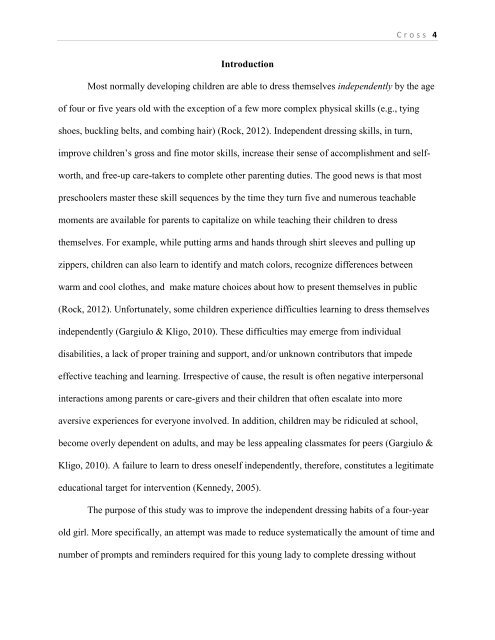THE EFFECTS OF A TIMER AND MYSTERY MOTIVATORS ON THE ...
THE EFFECTS OF A TIMER AND MYSTERY MOTIVATORS ON THE ...
THE EFFECTS OF A TIMER AND MYSTERY MOTIVATORS ON THE ...
Create successful ePaper yourself
Turn your PDF publications into a flip-book with our unique Google optimized e-Paper software.
C r o s s 4<br />
Introduction<br />
Most normally developing children are able to dress themselves independently by the age<br />
of four or five years old with the exception of a few more complex physical skills (e.g., tying<br />
shoes, buckling belts, and combing hair) (Rock, 2012). Independent dressing skills, in turn,<br />
improve children’s gross and fine motor skills, increase their sense of accomplishment and selfworth,<br />
and free-up care-takers to complete other parenting duties. The good news is that most<br />
preschoolers master these skill sequences by the time they turn five and numerous teachable<br />
moments are available for parents to capitalize on while teaching their children to dress<br />
themselves. For example, while putting arms and hands through shirt sleeves and pulling up<br />
zippers, children can also learn to identify and match colors, recognize differences between<br />
warm and cool clothes, and make mature choices about how to present themselves in public<br />
(Rock, 2012). Unfortunately, some children experience difficulties learning to dress themselves<br />
independently (Gargiulo & Kligo, 2010). These difficulties may emerge from individual<br />
disabilities, a lack of proper training and support, and/or unknown contributors that impede<br />
effective teaching and learning. Irrespective of cause, the result is often negative interpersonal<br />
interactions among parents or care-givers and their children that often escalate into more<br />
aversive experiences for everyone involved. In addition, children may be ridiculed at school,<br />
become overly dependent on adults, and may be less appealing classmates for peers (Gargiulo &<br />
Kligo, 2010). A failure to learn to dress oneself independently, therefore, constitutes a legitimate<br />
educational target for intervention (Kennedy, 2005).<br />
The purpose of this study was to improve the independent dressing habits of a four-year<br />
old girl. More specifically, an attempt was made to reduce systematically the amount of time and<br />
number of prompts and reminders required for this young lady to complete dressing without
















